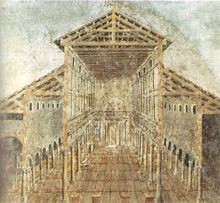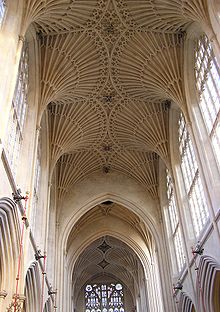Nave
This article needs additional citations for verification. (January 2010) |



The nave /ˈneɪv/ is the central aisle of a basilica church, or the main body of a church (whether aisled or not) between its western wall and its chancel. It is the zone of a church accessible by the laity.[1]
The nave extends from the entry — which may have a separate vestibule (the narthex) — to the chancel and may be flanked by lower side-aisles[2] separated from the nave by an arcade. If the aisles are high and of a width comparable to the central nave, the structure is sometimes said to have three naves. It provides the central approach to the high altar.
The term nave is from medieval Latin navis (ship). A ship was an early Christian symbol.[3][4] The term may also have been suggested by the keel shape of the vaulting of a church. In many Scandinavian and Baltic countries a model ship is commonly found hanging in the nave of a church,[5] and in some languages the same word means both 'nave' and 'ship', as for instance Danish skib or Swedish skepp.
History

The earliest churches were built when builders were familiar with the form of the Roman basilica, a public building for business transactions. It had a wide central area, with aisles separated by columns, and with windows near the ceiling. Old St. Peter's Basilica in Rome is an early church which had this form. It was built in the 4th century on the orders of Roman emperor Constantine I, and replaced in the 16th century.[3][6]
The nave, the main body of the building, is the section set apart for the laity, while the chancel is reserved for the clergy. In medieval churches the nave was separated from the chancel by the rood screen; these, being elaborately decorated, were notable features in European churches from the 14th to the mid-16th century.[3][6][7]
Medieval naves were divided into bays, the repetition of form giving an effect of great length; and the vertical element of the nave was emphasized. During the Renaissance, in place of dramatic effects there were more balanced proportions.[6]
Record-holders

- Longest nave in Denmark: Aarhus Cathedral, 93 metres (305 ft).
- Longest nave in England: St Albans Cathedral, St Albans, 84 metres (276 ft).
- Longest nave in Ireland: St Patrick's Cathedral, Dublin, 91 metres (299 ft) (externally).
- Longest nave in France: Bourges Cathedral, 91 metres (299 ft), including choir where a crossing would be if there were transepts.
- Longest nave in Germany: Cologne cathedral, 58 metres (190 ft), including two bays between the towers.
- Longest nave in Italy: St Peter's Basilica in Rome, 91 metres (299 ft), in four bays.
- Longest nave in Spain: Seville, 60 metres (200 ft), in five bays.
- Longest nave in the United States: Cathedral of Saint John the Divine, New York City, United States (Episcopal), 70 metres (230 ft).
- Highest vaulted nave: Beauvais Cathedral, France, 48 metres (157 ft) high but only one bay of the nave was actually built but choir and transepts were completed to the same height.
- Highest completed nave: Rome, St. Peter's, Italy, 46 metres (151 ft) high.
See also
- Abbey, with architectural discussion and groundplans
- Cathedral architecture
- Cathedral diagram
- List of highest church naves
References
- ^ Oxford Dictionary of Architecture and landscape Architecture, p518.
- ^ Nave (definition from Answers.com, accessed 11 February 2015.)
- ^ a b c Nave New Advent encyclopedia, accessed 25 March 2014.
- ^ Ship as a Symbol of the Church (Bark of St. Peter) Jesus Walk, accessed 11 February 2015.
- ^ "Ship hangs in balance at Pella Evangelical Lutheran Church". Sidney (Montana) Herald. 10 June 2008. Retrieved 3 January 2016.
{{cite web}}: Italic or bold markup not allowed in:|work=(help) - ^ a b c Nave Encyclopedia Britannica, accessed 11 February 2015.
- ^ Rood screen Encyclopedia Britannica, accessed 11 February 2015.
